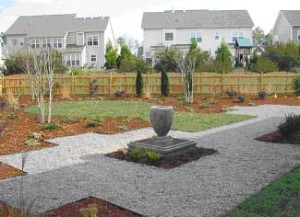Generally I try to design without respect to the current season – I like to plant perennials in winter, evergreens in summer, and everything in between to achieve a garden that looks great year round. But, there are plants that I am reminded to use more of when I see them putting on a great display come fall. Read on to learn about two native plants with dramatic fall berry displays – Callicarpa americana and Ilex verticillata.
Selecting a Japanese Maple
October is a great month for fall color and trees including Japanese Maples (Acer palmatum) really shine. While most people have heard of or seen Japanese Maples in the landscape many do not appreciate the range of plants that are included in this species. Read on for information on how to distinguish the plants among this group, and how to select one for your garden.
Fall Blooming Perennials for Shade
As summer ends and fall begins hot colors abound in the garden. Plants such as Goldenrods, Asters, and Sedum are at their peak and Cannas and Echinaceas are continuing to bloom as well. Given the length of the summer growing season in central North Carolina, by the end of August I find myself fatigued with the hot colors that I was so excited to see just a few months ago. I know that it will be weeks before cooler temperatures and fall foliage displays begin, but I want something fresh and cool to tide me over until then. Read on to learn about two of my favorite plants for this time of year.
Water is a common element found throughout garden design – often when we meet with clients they ask us about adding a water feature or fountain to their property. Water can add visual interest, sound, encourage wildlife, and be the finishing touch that makes your landscape pop. Water features can also be high maintenance, and we regularly see properties where they have fallen into poor repair and disuse. Read on to learn about some important things to consider when adding water to your garden.

(This fountain creates a centerpiece within the patio above, and is positioned to be viewed from the property owner’s home office)
Mulch Mold
This time of year, we get lots of calls regarding a yellow, orange, or brown fungus that looks likes dog vomit. Our clients want to know what it is, how it got into their yard, and how they can get rid of it. The scientific name is Fuligo septica, also known as dog vomit slime mold, it feeds on organic matter in the soil and mulch, and there is no way to stop it from being present in your yard. The good news is that it is harmless and will eventually go away.
As the spring and summer growing seasons get into full swing you may notice an unwanted addition to your garden – Toxicodendron radicans – or Poison Ivy. Although a native plant to North Carolina, few gardeners embrace or encourage the growth of this plant, and while not everyone is allergic to the plant, this can change over time, with allergy developing as a result of repeated exposure.
You may have heard the phrase ‘leaves of three, leave them be’ referring to the common identifying feature of poison ivy being its three leaflets. Unfortunately, many plants have three leaflets. One plant that is often confused with poison ivy is another native plant Parthenocissus quinquefolia – or Virginia Creeper. When mature, Virginia Creeper develops five leaflets, but as it is leafing out or putting on new growth it looks very similar to Poison Ivy.
Every spring I get emails from friends and family asking me to identify a grassy green plant with pretty purple flowers that is blooming everywhere. The answer – Liriope! While I used to be surprised at the number of people asking me about this (somewhat boring, in my opinion) plant, I have since come to appreciate everything it has to offer. A shade tolerant, flowering, evergreen groundcover, Liriope is available in two main types – Liriope muscari a clump forming variety and Liriope spicata a vigorously spreading variety. While Liriope is universally popular, there are many other groundcover grasses worth considering.
Time For Spring Dogwood Selections
Spring is here and the Dogwoods are blooming! Many of our clients love Dogwoods and want to incorporate one (or more) into their landscape design. Fortunately, there are a variety of Dogwoods available in the landscape industry, making it easy to find one that will work for almost any site. Read on to learn about how to pick the best Dogwood for your property.
Spring Ephemerals
While most everyone is familiar with the appearance of spring flowering bulbs there is another group of plants that can add a great deal of spring interest to your garden – spring ephemerals. Ephemerals are plants that emerge in spring and progress through their flowering and fruiting and enter dormancy by the beginning of summer. These plants take advantage of ample spring moisture and the sunlight that streams through deciduous trees (before they develop their yearly foliage). Read on for a few examples of spring ephemerals that work well in North Carolina.
With spring around the corner now is the time to perform some routine winter maintenance – cutting back your ornamental grasses. The dried foliage of these plants has provided great fall and winter interest, but to encourage healthy new growth and a neat appearance, this foliage now needs to be removed. Read on for easy step by step directions.
